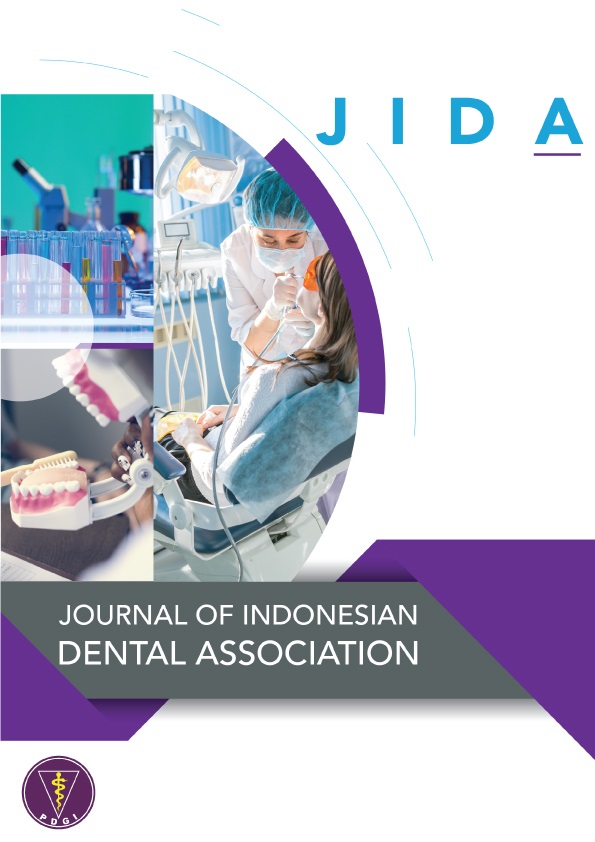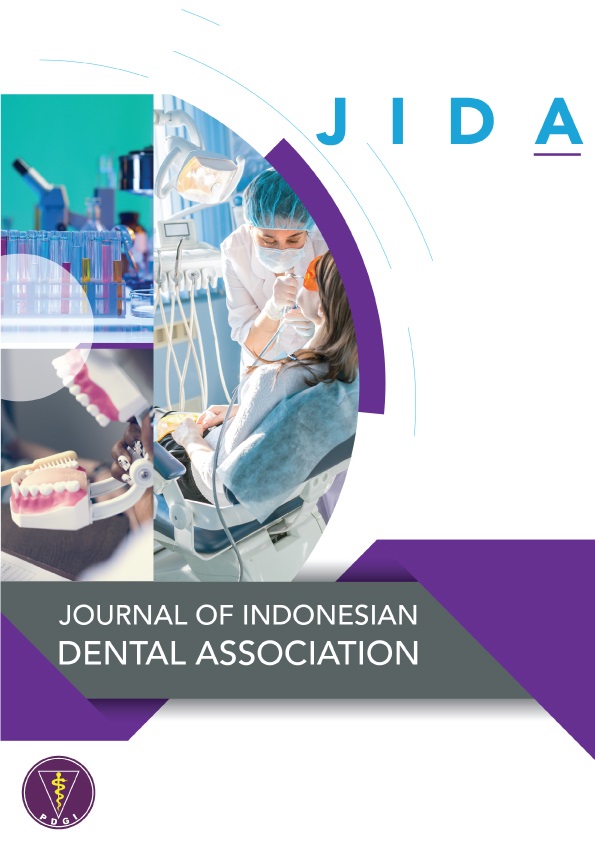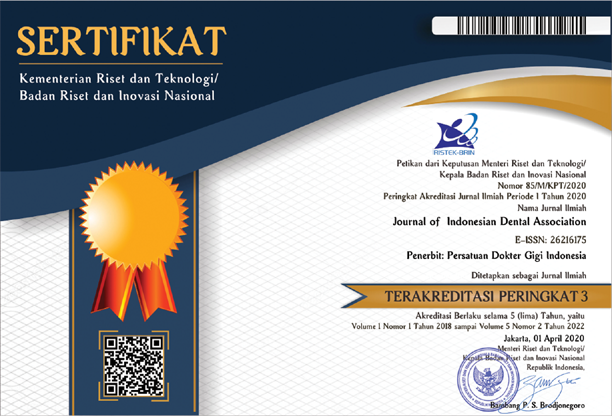Post-Orthodontic Evaluation of Incisor Position on Class I Malocclusion Patients: A Radiographic Study
Abstract
Background: Malocclusion is the irregularity of teeth, considered as an oral health problem resulting from various etiological factors, causing esthetic dissatisfaction to functional impairment. Malocclusions must be fixed by orthodontic treatment. Achieving proper incisor inclination and angulation is essential for orthodontic treatment stability and facial harmony. However, limited evidence exists regarding post-treatment incisor positioning in Class I skeletal malocclusion patients within the Indonesian population. Objective: This study aimed to analyze the post-treatment inclination and angulation of maxillary and mandibular incisors in Class I skeletal malocclusion patients and to evaluate whether these parameters fall within established cephalometric norms. Methods: A descriptive cross-sectional analysis was conducted using secondary cephalometric data from 96 post-treatment medical records. Incisor inclination was measured using U1–SN, U1–PP, L1–MP, and IMPA angles, while angulation was assessed for upper and lower central incisors. Results: The mean upper incisor angles were 106° (U1-SN) and 115° (U1-PP), and the lower incisor angles were 94° (L1-MP) and 96° (IMPA). The mean angulation of individual incisors was approximately 89–91° for both upper and lower central incisors. Conclusion: Pre-adjusted bracket systems used in the study effectively guide incisors toward favorable positioning within normal ranges, with minor variations such as the IMPA angle, supporting both functional and esthetic outcomes.This study took the initiative to describe both post-treatment upper and lower incisor position in Indonesian orthodontic patients.References
1. FDI World Dental Federation. Malocclusion in orthodontics and oral health. Int Dent J. 2020.
2. Alogaibi YA, Murshid ZA, Alsulimani FF, Linjawi AI, Almotairi M, Alghamdi M, et al. Prevalence of malocclusion and orthodontic treatment needs among young adults in Jeddah city. J Orthod Sci. 2020;9(1):3-10
3. Badan Penelitian dan Pengembangan Kesehatan RI. Hasil Riset Kesehatan Dasar (RISKESDAS). 2018. p. 94.
4. Sangalli L, Dalessandri D, Bonetti S, Mandelli G, Visconti L, Savoldi F. Proposed parameters of optimal central incisor positioning in orthodontic treatment planning: A systematic review. Korean J Orthod. 2022;52(1):53-65.
5. Seidel CL, Baumert U, Ost F, Sabbagh H, Wichelhaus A. Inclination changes in incisors during orthodontic treatment with passive self-ligating brackets. J Clin Med. 2025;14(10):3370.
6. Aloufi NM, Al Qazlan FS, Alfawzan AA. Mandibular incisors angulation and position among various vertical facial patterns: An artificial intelligence-based cephalometric study. Bioinformation. 2025;28;21(2):113-115.
7. Maringka SMF, Buntara MJH. Gambaran inklinasi insisivus sentral maksila pada pasien ortodonti usia 18-25 tahun berdasarkan analisis sudut U1-SN. Jurnal Kedokteran Gigi Terpadu. 2024;6(1):87-90.
8. Andrews Foundation. The six elements orthodontic philosophy: goals, diagnosis, classification, and treatment.2025.https://www.andrewsfoundation.org/ publications.html
9. Alqahtani H. Trends and protocols in orthodontic finishing: a cross-sectional study. J Int Clin Dent Res Organ. 2025;17(1):69–77.
10. Peter E, Monisha J. Composite lateral cephalometric norms – a pooled estimate of 137 Indian studies. J Contemp Orthod. 2024;8(2):156-71.
11. Ellis E, McNamara JA. Cephalometric evaluation of incisor position. Angle Orthod. 1986;56(4):324–44.
12. Guo R, Zhang L, Hu M, Huang Y, Li W. Alveolar bone changes in maxillary and mandibular anterior teeth during orthodontic treatment: A systematic review and meta-analysis. Orthod Craniofac Res. 2021;24(2):165-179.
13. Alqhtani NR, Alenazi A, Alqahtani AS, Gufran K, Robaian A, Alqahtani AM, Aldossary SF, Aldossry MF. Labial alveolar bone thickness and its correlation with buccolingual maxillary incisors angulation: a CBCT based study. Eur Rev Med Pharmacol Sci. 2022 Jul;26(13):4625-4633. doi: 10.26355/eurrev_202207_29184.
14. Dalaie K, Hajimiresmail YS, Safi Y, Baghban AA, Behnaz M, Rafsanjan KT. Correlation of alveolar bone thickness and central incisor inclination in skeletal Class I and II malocclusions with different vertical skeletal patterns: A CBCT study. Am J Orthod Dentofacial Orthop. 2023;164(4):537-44. doi:10.1016/j.ajodo.2023.02.021.
15. Pour RD, Papageorgiou SN, Safi S, Eble OS, Jäger A, Gölz L. Clinical implementation of axial angulation of incisors in the course of routine fixed appliance treatment - a retrospective cohort study. Clin Oral Investig. 2023;27(2):659-669.
16. Littlewood SJ, Mitchell L. An introduction to orthodontics. 5th edition. Oxford, United Kingdom: Oxford University Press. 2019. p. 236.
17. Cobourne MT, DiBiase AT. Handbook of orthodontics. 3rd edition. Elsevier Science. 2024.
18. Ma, L., Han, J., Wang, Z., & Zhang, D. (2023). CephGPT-4: An interactive multimodal cephalometric measurement and diagnostic system with visual large language model. arXiv. https://doi.org/10.48550/arXiv.2307.07518
2. Alogaibi YA, Murshid ZA, Alsulimani FF, Linjawi AI, Almotairi M, Alghamdi M, et al. Prevalence of malocclusion and orthodontic treatment needs among young adults in Jeddah city. J Orthod Sci. 2020;9(1):3-10
3. Badan Penelitian dan Pengembangan Kesehatan RI. Hasil Riset Kesehatan Dasar (RISKESDAS). 2018. p. 94.
4. Sangalli L, Dalessandri D, Bonetti S, Mandelli G, Visconti L, Savoldi F. Proposed parameters of optimal central incisor positioning in orthodontic treatment planning: A systematic review. Korean J Orthod. 2022;52(1):53-65.
5. Seidel CL, Baumert U, Ost F, Sabbagh H, Wichelhaus A. Inclination changes in incisors during orthodontic treatment with passive self-ligating brackets. J Clin Med. 2025;14(10):3370.
6. Aloufi NM, Al Qazlan FS, Alfawzan AA. Mandibular incisors angulation and position among various vertical facial patterns: An artificial intelligence-based cephalometric study. Bioinformation. 2025;28;21(2):113-115.
7. Maringka SMF, Buntara MJH. Gambaran inklinasi insisivus sentral maksila pada pasien ortodonti usia 18-25 tahun berdasarkan analisis sudut U1-SN. Jurnal Kedokteran Gigi Terpadu. 2024;6(1):87-90.
8. Andrews Foundation. The six elements orthodontic philosophy: goals, diagnosis, classification, and treatment.2025.https://www.andrewsfoundation.org/ publications.html
9. Alqahtani H. Trends and protocols in orthodontic finishing: a cross-sectional study. J Int Clin Dent Res Organ. 2025;17(1):69–77.
10. Peter E, Monisha J. Composite lateral cephalometric norms – a pooled estimate of 137 Indian studies. J Contemp Orthod. 2024;8(2):156-71.
11. Ellis E, McNamara JA. Cephalometric evaluation of incisor position. Angle Orthod. 1986;56(4):324–44.
12. Guo R, Zhang L, Hu M, Huang Y, Li W. Alveolar bone changes in maxillary and mandibular anterior teeth during orthodontic treatment: A systematic review and meta-analysis. Orthod Craniofac Res. 2021;24(2):165-179.
13. Alqhtani NR, Alenazi A, Alqahtani AS, Gufran K, Robaian A, Alqahtani AM, Aldossary SF, Aldossry MF. Labial alveolar bone thickness and its correlation with buccolingual maxillary incisors angulation: a CBCT based study. Eur Rev Med Pharmacol Sci. 2022 Jul;26(13):4625-4633. doi: 10.26355/eurrev_202207_29184.
14. Dalaie K, Hajimiresmail YS, Safi Y, Baghban AA, Behnaz M, Rafsanjan KT. Correlation of alveolar bone thickness and central incisor inclination in skeletal Class I and II malocclusions with different vertical skeletal patterns: A CBCT study. Am J Orthod Dentofacial Orthop. 2023;164(4):537-44. doi:10.1016/j.ajodo.2023.02.021.
15. Pour RD, Papageorgiou SN, Safi S, Eble OS, Jäger A, Gölz L. Clinical implementation of axial angulation of incisors in the course of routine fixed appliance treatment - a retrospective cohort study. Clin Oral Investig. 2023;27(2):659-669.
16. Littlewood SJ, Mitchell L. An introduction to orthodontics. 5th edition. Oxford, United Kingdom: Oxford University Press. 2019. p. 236.
17. Cobourne MT, DiBiase AT. Handbook of orthodontics. 3rd edition. Elsevier Science. 2024.
18. Ma, L., Han, J., Wang, Z., & Zhang, D. (2023). CephGPT-4: An interactive multimodal cephalometric measurement and diagnostic system with visual large language model. arXiv. https://doi.org/10.48550/arXiv.2307.07518
Published
2025-10-29
How to Cite
KARTINI, Valerie; PURWANEGARA, Miesje Karmiati; KUSUMAH ADIWIRYA, Muhammad Sulaiman.
Post-Orthodontic Evaluation of Incisor Position on Class I Malocclusion Patients: A Radiographic Study.
Journal of Indonesian Dental Association, [S.l.], v. 8, n. 2, p. 102-108, oct. 2025.
ISSN 2621-6175.
Available at: <http://jurnal.pdgi.or.id/index.php/jida/article/view/1404>. Date accessed: 10 dec. 2025.
doi: https://doi.org/10.32793/jida.v8i2.1404.
Section
Research Article

This work is licensed under a Creative Commons Attribution-NonCommercial 4.0 International License.












